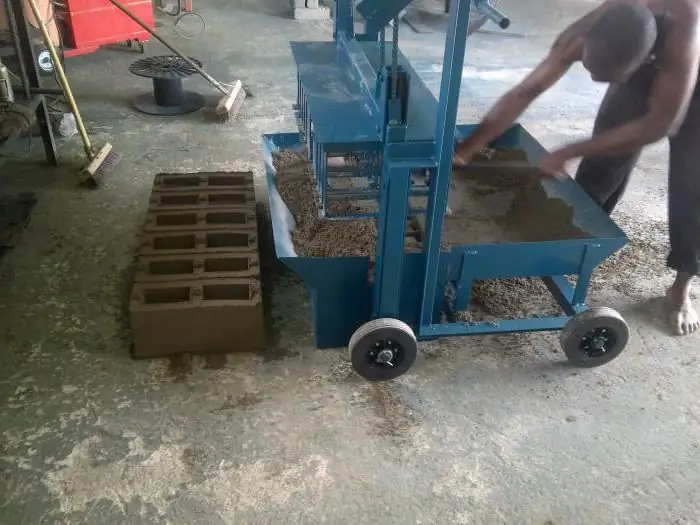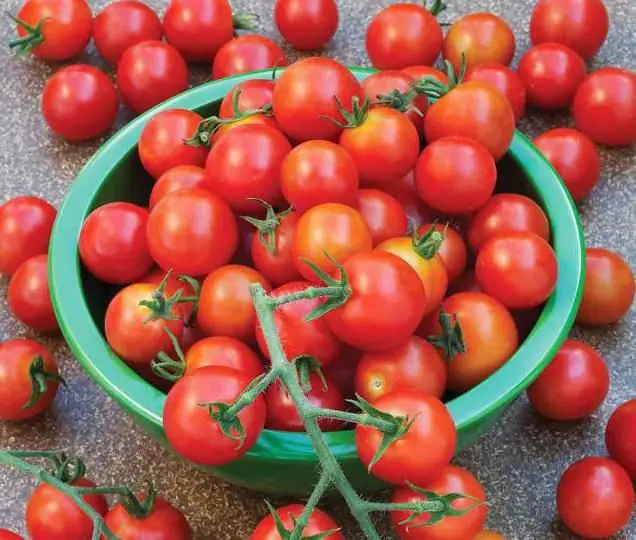2026 Author: Howard Calhoun | [email protected]. Last modified: 2025-01-24 13:10:41
Corn is a valuable crop grown in many regions of our country. In 2018, for example, about 2.5 million hectares of land were occupied for it in Russia. The yield of corn depends on several factors. In any case, the cultivation of this crop can be expedient only if the required care technologies are strictly observed and the variety is chosen correctly.
Using corn
This crop is grown in the fields mainly as fodder. Corn grain, as well as, for example, silage from its stalks, can be fed to any farm animal. The main advantage of corn feed, the owners of farms specializing in the cultivation of pigs, cattle, rabbits, poultry, consider its high nutritional value. In this regard, corn is superior to many other cereal crops.

Also, the grain of this plant is widely used in the food industry. It is usedin the preparation of starch, flour, for baking confectionery, canning, etc.
Biological features
Maize refers to grain crops. However, in terms of biological characteristics, it is very different from most representatives of this group. The main characteristic features of this plant are, of course, a very powerful root system and stem, wide leaves, as well as large grains.
Corn can reach a height of 5 m. Its root system, like that of other cereals, is fibrous. However, at the same time, it can go 2 m deep into the soil. A thick corn stalk inside is filled with a spongy mass. In young plants, it is also very juicy and contains a lot of sugar.
The leaves of corn are wide, with wavy edges. Each plant develops one male and one female inflorescence during the growing season. The latter is in the process of maturation and forms an ear.
Types of corn
Only 8 varieties of this culture are distinguished by biological characteristics. However, only five of them are of economic importance:
- sweetcorn;
- dentate;
- bursting;
- siliceous;
- starchy.
Sweet corn is primarily used as human food in boiled form. Also, the grains of this variety are usually used for the preparation of canned food. Subsequently, such a product can be used, for example, in the preparation of salads.

The grain of dent corn has a characteristic depression in the upper part. Its shape is wedge-shaped. That is, outwardly, such a grain resembles a horse's tooth, from where the name of the variety came from. The features of such varieties are, first of all, a well-developed stem and high yield. Thanks to these features, dent corn is quite popular in our country.
In the siliceous variety, the grain is flattened on the sides and has a rounded top. Most of the varieties and hybrids of this group are characterized by precocity.
Popcorn is characterized primarily by small grains. It is grown in Russia not too often. The grain of this variety has a pointed top and bursts during heat treatment.
Starchy corn has a very soft grain. Its distinctive feature is also mealy endosperm. This variety is grown mainly for the subsequent processing of grain into starch, molasses and oil.
In addition to varieties, breeders also bred hybrids of corn. The yield of such plants can actually be very high. Hybrids have this feature due to heterosis.
What is the average yield of corn in Russia
A distinctive feature of this crop is, among other things, the ability to collect a large amount of grain. In the world, according to this indicator, corn currently exceeds wheat by 1.7 times, rice - by 1.2 times. In Russia, unfortunately, not as much attention is paid to this plant as we would like. because ofthe use of imperfect cultivation technologies, the average corn yield per hectare in Russia is much lower than in the world. Unfortunately, there are not too many good domestic varieties of this crop, ideally adapted to the not very favorable climate of our country.

The average yield of corn in Russia in 2018 is 35-45 c/ha. For example, for wheat, this figure is 60 c/ha. First of all, the low yield of this crop is due to the fact that it is usually not watered in the farms of the Russian Federation. Meanwhile, artificial irrigation using almost any cultivation technology can raise the corn yield to 100-110 c/ha. Sometimes, under the condition of watering during the growing season, farms achieve even better results.
What yields may depend on
Irrigated corn thus produces larger cobs and in greater quantities. However, the yield of this crop, of course, can be influenced by other factors. First of all, it's the right choice:
- varieties;
- pre-sowing tillage method.
Cultivation techniques
In our country, as in many other countries of the world, only two main technologies for growing corn are used:
- for grain;
- for fodder green mass.
Cultivation methods in both these cases are similar. The difference between them lies mainly in the choice of the appropriatevarieties for planting in the fields.
Influence of tillage methods on corn yields
When growing this crop, it is very important to properly prepare the fields for planting seeds. When choosing a specific technique for the main and pre-sowing tillage for corn, the following factors should be taken into account:
- features of predecessors;
- terms of harvesting predecessors;
- degree of contamination of fields;
- predominant weed varieties.
For example, when placing corn after early maturing crops of continuous sowing on the fields, the stubble is stubbled twice with disc equipment to a depth of 8-10 cm. Using this technique, about 76% of weeds die on the fields. At the same time, the yield of corn from 1 hectare increases by about 3 centners.

In the event that the fields are heavily clogged with root-shooting perennial grasses, the stubble is also peeled twice with disk equipment. In addition, plow or flat-cutting processing is also carried out to a depth of 14-15 cm. After the first peeling, in this case, herbicides are applied to the fields.
In the south of the country, where the post-harvest period is usually long, improved tillage technology is being used to kill perennial weeds. In this case, the following operations are performed on the fields:
- disc peeling to a depth of 6-8 cm immediately after grain harvest;
- body peeling 12-14 cm or shallow plowing 14-18see
Also in the southern regions, before deep plowing in September, procedures such as cultivation and harrowing can be carried out.
The impact of tillage methods on corn yields is great. In particular, this applies to those cases when this crop is cultivated in the fields for several years. When using this cultivation technology, for better incorporation of stubble residues, they are crushed with disc cultivators or harrows, processing the field in two directions to a depth of 8-10 cm. At the same time, they try to harvest the predecessor at the lowest possible cut.
In dry regions, the soil for corn is usually cultivated with flat cutters. Chernozems for corn are plowed to a depth of 25-30 cm. Arable lands with a smaller nutrient layer are cultivated throughout the entire thickness of the latter.
Dependence of yield on variety
Selection work with corn in our country, unfortunately, is not very extensive. There are not many varieties that give good yields. But nevertheless, such varieties in Russia, of course, are available. Currently showing the best yield of corn varieties:
- Gamma - Russian Krasnodar, very unpretentious and fast growing hybrid (up to 145 q/ha).
- Krasnodar grain with a ripening period of 85 days and a yield of 119 q/ha.
- Athlete is a tall plant with a ripening period of 85-88 days and a maximum yield of 127-137 c/ha.
- Porumbel is a three-line hybrid with a maturity of only 65days.
Also, the hybrid SI Phenomenon can be cultivated in the fields in Russia. The yield of corn of this variety is 120-130 q/ha. This hybrid belongs to the group of early ripe ones.
The most popular varieties of feed corn grown for silage are:
- Partizanka - accumulates up to 90% of all starch and 14% of fats in the stem (feed units - 6400/ha);
- Krasnodar 4 - hybrid with dense tall stems (8700/ha);
- Sterling - disease resistant variety (up to 6950/ha).
Features of corn cultivation: predecessors
Methods of cultivating this crop for grain and for silage, as already mentioned, are used almost the same. The fields are simply sown with the appropriate variety of corn, which gives a lot of high-quality marketable grain or green mass. The only thing is that when grown for fodder, this plant is sometimes placed in the fields simultaneously with other crops included in the diet of farm animals. This does not affect the yield of silage corn in any way.
The best predecessors for this plant are legumes and legumes, as well as spikes fertilized with manure. When planted after such plants, the yield of corn per hectare is likely to be maximum. On nutrient soils, this crop is allowed to be grown for several years in one place. If less than 50% of the prescribed norm is applied on the fields, it is allowed to cultivate corn in the same field for no longer than 3-5 years. In this case, it is usually alternate with alfalfa grown for 3-4 years.

Soils and site selection
The yield of corn in Russia, as elsewhere in the world, depends, of course, also on the correct choice of planting site. This crop is usually placed in agricultural enterprises only on fairly loose soil containing many micro and macro elements. In those fields where the soil is acidic, it is not recommended to grow corn. In extreme cases, before planting this crop, such land must be limed. In autumn, during the main tillage for corn, organic fertilizers are usually applied. In the spring, they use mineral:
- phosphorus - in the amount of 60-80 kg/ha;
- potash - 90-120 kg/ha;
- nitrogen - 90-120 kg/ha.
When choosing a site for this crop, among other things, it is recommended to pay attention to the relief. This factor also has a significant impact on the yield of corn. It is believed that this culture develops best in areas with a southern exposure. In regions with a temperate climate, it is recommended to plant corn in fields covered from the north or northeast by forests, hills, etc.
Sowing
Maize seeds are supposed to be treated for disease prevention 15 days before planting. With early sowing in fields not cultivated by harrowing, the planting material of this crop is deepened by 2-3 cm. In the event that the soil was harrowed, this figure is increased by1-2 cm.

When cultivating for grain, the consumption of corn seeds during planting is usually 70-80 thousand pieces/ha. For varieties grown for silage, this figure will be 90-120 thousand units/ha.
How corn is cared for
During the growing season, when growing this crop, among other things, the following operations are performed:
- pre-emergence harrowing - 4-6 days after planting;
- second harrowing after 15 days (produced if no herbicides were applied to the soil for the first time);
- post-emergence harrowing in the phase of 3-4 leaves;
- inter-row treatments - after row designation;
- hilling at a height of 25-30 cm.
In case of severe infestation of fields with corn, among other things, they are treated with herbicides.
Cleaner
The yield of corn per 1 hectare, subject to all cultivation technologies and the right choice of variety, can therefore be very high. But, of course, this culture, among other things, also needs to be properly removed. Otherwise, the yield may be significantly reduced due to grain losses in the field.
To harvest if the plants were grown for silage, they start in the phase of wax or milk ripeness of the grain, or after damage to the green mass by frost. The cutting length of the stems in this case is 2-5 cm, and the cutting height is 10-12 cm.
Cob harvesting is done whenmoisture content of corn grain will reach 40%. At the same time, combines of a special design are used in the fields. If the cobs are intended for feeding livestock, they are pre-cut into pieces. Then they are either given fresh to farm animals, or ensiled in combination with other ingredients.

If cobs were grown to produce marketable grain, they are first peeled. Next, the corn is dried to a moisture content of 25-30%. After threshing, the grain is cleaned. Then it is dried using special equipment. At the final stage, the grain prepared in this way is supplied to food industry enterprises.
Recommended:
"Euroset", "Corn" card: how to get. Credit card "Corn": conditions for obtaining, tariffs and reviews

The ever-increasing competition in the financial market forces organizations to create more and more new programs that most accurately respond to consumer needs and empower them. Sometimes, it would seem, completely different organizations engaged in different activities come together for mutually beneficial cooperation. An example of such a successful combination was the "Corn" ("Euroset") card
Potato yield per 1 ha. Potato production technology. Varieties (photo)

The article is devoted to one of the most popular agricultural crops - potatoes. The issues of cultivation, storage, fertilization, use of equipment are touched upon, as well as the best varieties recommended for production are described
Business idea: production of bricks. Technology and installation for the production of bricks

You can create your own business that will meet your requirements and also become a source of income. However, in order to obtain high-quality bricks, it is necessary to comply with the technical conditions and adhere to the manufacturing process. The production of bricks at home does not involve the use of expensive equipment. The most important condition is the correct preparation of raw materials
Production of wooden windows: production technology

It is impossible to imagine a living space without a window, which is a conductor between the inner and outer space. Windows are made from different materials. But how wooden windows are made, and what types of them exist, read the article
Sweet varieties of tomatoes: reviews. Sweet varieties of tomatoes for greenhouses

Gardeners plant various vegetables. Sweet varieties of tomato are considered one of the most sought-after varieties, as they are ideal for different occasions. More about them will be discussed in the article

